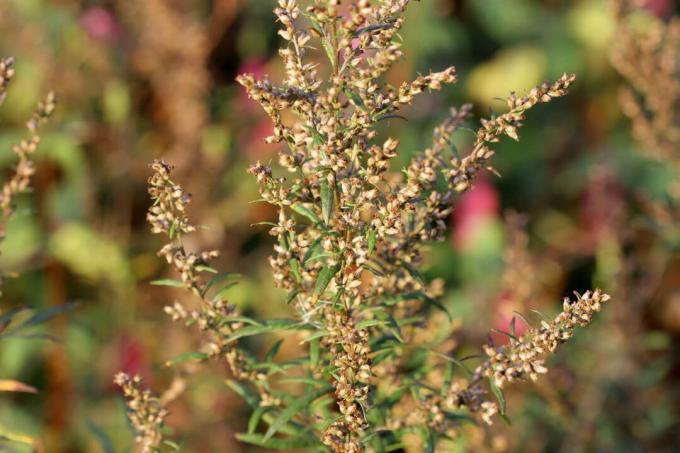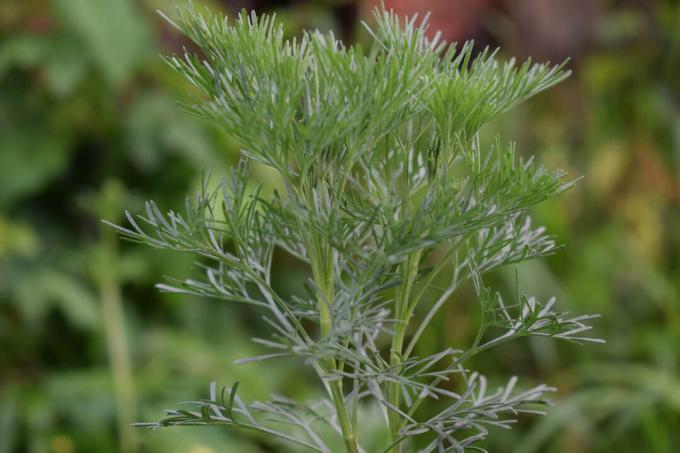Cola cabbage is healthy, grows in your own garden and tastes like cola. The herb, which is easy to grow, is a real asset to any garden.

In case you have ever wondered what cola cabbage (Artemisia abrotanum var. maritima) is and whether there is such a thing at all, you have come to the right place with this article. We introduce the special garden plant and give tips on cultivating the cola herb and using the subspecies of the boarwood.
contents
- Cola herb: flowering, origin and properties
- Related types and varieties of cola herb
- Growing boarwood: location and procedure
-
Care of cola herb
- Cutting, watering and fertilizing
- Eberraute turns brown: what to do?
- Propagate cola herbs
- Is cola herb hardy?
- Harvesting and using cola herb
- Effect of the boarwood
Cola herb: flowering, origin and properties
The boarwood originally comes from south-east Europe. Therefore it copes very well with warm and dry climates and prefers sunny locations. Nevertheless, the subshrub, also known as stickroot, is considered winter hardy with us. The individual sprouts from which the cola bush is composed can be up to 1 m high. Together with the pinnate, silver-green leaves, they are responsible for its bushy appearance.
The cola herb blooms from July to September. This is when the yellowish flowers of the wild boarwood appear, which are actually very small. However, they stand together in cup-like inflorescences and thus leave a wonderful impression. Unfortunately, the cola plant often does not flower in more northerly areas, including here in Germany. In warm summers, however, the bushes often not only bloomed, but also produced fruits. In contrast to many other boarwood species, the cola herb does not have a strong smell that takes getting used to. On the other hand, it smells pleasantly and intensely of cola, which is a small sensation in every garden.

Related types and varieties of cola herb
The cola herb is a subspecies of the boarwood (Artemisia abrotanum). But there are other close relatives of the cola herb, which also stand out due to their characteristic smell. Since all the plants presented belong to the same species, their requirements in terms of location and care are similar.
- Camphor boarwood (Artemisia abrotanum var. camphorata): The camphor rowan has a higher content of camphor, which is why it tastes bitter and very spicy. However, bitter substances are very healthy and support digestion, for example, which is why the camphor boarwood is well suited to seasoning high-fat dishes.
- Lemon Rowan (Artemisia abrotanum var. citrata): The lemon rue smells and tastes, as the name suggests, very lemony. In addition, their leaves are a little more delicate than most other hornbeams.
- French rowan (Artemisia abrotanum ‘Courson’): This variety of boarweed stands out for its complex and multi-layered aroma. The French boarwood is also excellent as an ornamental plant for borders or hedges.

Growing boarwood: location and procedure
Since the homeland of the Eberraute is in Southeast Europe, the preferred locations for cola cabbage are sunny, warm and sheltered. The Coca-Cola bush, on the other hand, makes little demands on the soil. It needs neither a lot of nutrients nor a lot of water and feels most comfortable in well drained, deep and calcareous soils. Sand, gravel or stones support water drainage and help prevent waterlogging. This is because cola doesn't like her at all. The small shrub can only tolerate cultivation in a pot to a limited extent. If you want to try it anyway, you should choose a bucket that is as large as possible and, above all, deep, as the rowan tree develops deep roots.
The optimal planting time for cola is in spring from around May. Then the plants can be placed directly in the field at a distance of at least 40 cm. If you want to grow the cola plant from seeds yourself, a preculture from March is recommended. If you do a few things, it should just work out too. Alternatively, the seeds can be sown directly outdoors from mid-April. The best way to do this is to spread several seeds in one place so that you are protected if some seeds fail to germinate.

Procedure for the preculture of cola herb:
- Fill a shallow seed tray with a nutrient-poor soil. Our Plantura organic herb & seed compost is very well suited for this, for example.
- Eberrauten are among the light germs. Therefore, you should only scatter the cola cabbage seeds loosely on the earth and press them lightly, but not cover them with earth.
- For the next time you should keep the substrate consistently moist, but also make sure that it is not too wet.
- The optimal germination temperature of cola herbs is 20 ° C. Under these conditions, the seeds should germinate in approximately 10 to 12 days.
- Now, above all, the plants need a lot of light. Therefore, they should be on a very sunny window sill.
- After the first leaves have developed, the plants should be pricked out in their own pots so that they have enough space to develop their root system.
- In May, the plants should be ready to go out into the garden.
Tip: Cola herb prefers a lime-rich soil with a high pH value. If the Soil pH is rather acidic, a lime fertilization is therefore a good idea. For example, ours is well suited Plantura organic lawn & garden limewhich, thanks to its fine-grain structure, is easy to distribute and works quickly.
Care of cola herb
Cola cabbage is very undemanding in terms of care, as it neither needs a lot of nutrients nor a lot of water. You can find out what you need to consider in the following sections.
Cutting, watering and fertilizing
Due to its rather low nutritional requirements, cola cabbage does not necessarily have to be fertilized outdoors. But you can work a slow-acting fertilizer into the soil at the beginning of the growing season in spring to support the re-growth. The situation is different, however, when cola herbs are cultivated in pots. Regular fertilization with a slow release fertilizer is essential here. For example, our primarily organic one is ideal for both Plantura organic universal fertilizer with long-term effects or compost.
You don't have to worry about the water supply for most of the year either. The cola bush only needs water and should be watered in very hot and long dry periods.
Caring for the cola bush also includes cutting. The best time to do this is in spring. Cutting promotes dense, compact growth and the formation of young, aromatic shoots. If the shoots protrude far outwards, they can be cut off completely and the inside of the subshrub can also be thinned out a little.

Eberraute turns brown: what to do?
The fact that parts of the rowan tree turn brown can have various and in some cases completely natural causes. For one, cola herb is a subshrub, which means that older shoots become lignified and brown. Even in winter, browning is a completely normal process. In very severe frost it can happen that parts of the plant above ground turn brown and die. But that doesn't mean that the whole plant is dead. As a rule, it drives out again in the spring.
However, if the plant turns brown prematurely and takes care of it, this may also be due to too well-intentioned watering. Because cola herb does not tolerate waterlogging at all. If the cola bush has been in a very moist substrate for a long time, it is best to repot it. The roots can be cut and then the plant can be placed in fresh, dry, well-drained substrate.

Propagate cola herbs
The cola herb can be propagated either via seeds or cuttings. However, since it is not certain whether your plant will bloom and you can harvest the seeds of the wild boar, the easier way is usually via cuttings. The procedure for this is relatively simple and usually crowned with success.
- In late summer, cut off the top 10 cm from a young, green shoot and use it as a cutting.
- At the bottom, remove approximately the last 4 cm of all leaves.
- Then put the shoot in a small pot filled with herb and potting compost. You may be able to mix the soil with sand to increase the permeability of the substrate. As for seed cultivation, this is ours too Plantura organic herb & seed compost very suitable.
- In the near future it is important to keep the soil slightly moist throughout. The cuttings have a relatively large leaf area through which water evaporates, but no roots yet to absorb water from the soil.
- To keep evaporation as low as possible, the pot should be covered with a plastic bag.
- If the cuttings of the cola bush have grown well, this can be recognized by new leaf growth.

Is cola herb hardy?
Although it comes from the Mediterranean, cola herb is usually a hardy shrub in our country that can survive temperatures as low as - 23 ° C. So it shouldn't be a problem to overwinter cola herbs. But if you want to be on the safe side, you can also cover the root area with brushwood or straw. Cola shrub plants that are cultivated in pots, however, should best be overwintered frost-free.
Harvesting and using cola herb
The leaves of the cola bush can be used in the kitchen. They can be harvested throughout the growing season, although the bitter content also increases with age. The content of bitter substances in flowers and seeds is also relatively high, which is why these parts of the cola herb are usually not used. The leaves do not lose much of their aroma when they are dried or cooked. Therefore, it is possible to dry the cola cabbage and you should only approach the taste in small amounts when cooking. In order to live up to its name, the leaves can also be used to make cola lemonade or wild boar tea. For the lemonade, a syrup is made from shoot tips, sugar, lemon juice and water. For tea, the leaves are simply poured over with boiling water.

Note: The boarwood is non-poisonous, but as is so often the case: the quantity makes the poison. For example, if you consume too much, you may vomit. Pregnant and breastfeeding women should also refrain from taking cola herb, as the leaves contain the essential oil thujone, which has an antispasmodic effect and induces labor can.
Effect of the boarwood
Eberraute was cultivated for its medicinal properties as early as the Middle Ages and is therefore a typical cloister garden herb. The contained tannins and bitter substances support digestion and provide relief from stomach problems. It should be noted, however, that the content of bitter substances in camphor boarwood, for example, is significantly higher than in cola herb. Also will Artemisia abrotanum among other things ascribed an anti-inflammatory and antispasmodic effect. This is why a boar's vine tea can help with menstrual cramps, for example.

If you've taken a liking to extraordinary herbs, you've come to our article about Cheese cabbage precisely. It is also easy to draw and has a spicy cheese flavor.
